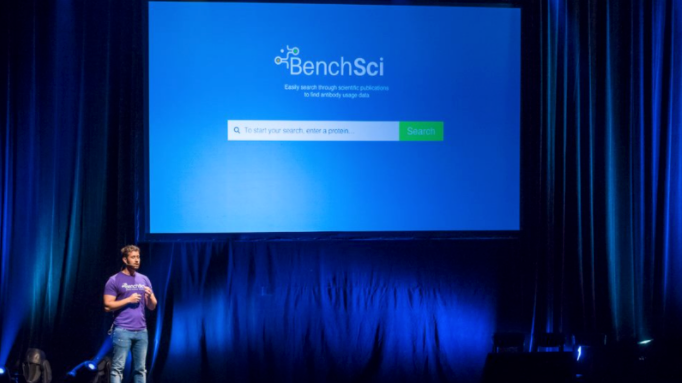How to Tell Your Startup’s Story in a Powerful Pitch Deck

If you never raised funding before, you might think that the most challenging and important part of the process is getting meetings with angels and investors. That’s what I thought when I had to raise money for BenchSci for the first time. I had moved to Canada 15 months prior and had no professional network. Through sheer perseverance, we scored a few investor meetings. After completely tanking those meetings, I realized how wrong I was. Getting the meetings isn’t the hard part. Telling an exciting and compelling story is.
Four years ago, I was fortunate to go through a three-month storytelling boot camp as part of BenchSci’s participation in FounderFuel, a startup accelerator that focuses on storytelling. For three months I pitched to VCs and other successful entrepreneurs on a weekly basis. After that three-month period, I presented BenchSci’s story to a live audience of 1,200 people. I was no longer tanking.
At FounderFuel, I learned how to tell great stories. I have kept working on that skill ever since because I believe that storytelling is the most important skill every CEO must master. Telling your company’s story is not only for investors, but also for employees, customers, partners, family, and more — t’s how you raise money, hire talent, manage crises, sell your product, and build your partner ecosystem. From my experience, a great story is the difference between success and failure. If you don’t believe me, ask yourself why some companies raise so much money when they haven’t achieved any of the usually required milestones. The answer: Their CEO tells a great story.
You can tell great stories too. In this post, I’ll share the lessons I’ve learned over the past couple of years as BenchSci’s CEO about the power of stories, and how to use it in your pitch decks.
Common myths and what really works
Before describing what I’ve found to work, I want to debunk two pitch deck misconceptions:
- You need to have a structure with the headers problem, solution, team, market size, etc. At BenchSci, we raised over $40M. We never used such a structure for any of our decks. Why? That’s not how you should tell a story. Imagine watching a movie and seeing every part titled. “Background.” “Plot twist.” “Crisis.” And so forth. That would not be engaging or enjoyable. So too with pitch decks. Your pitch deck should take the audience on a journey. You do that by telling a compelling story. You cover the key points, like the problem, solution, and team. But you do it without killing interest by boiling everything down to a few boring slides with obvious titles.
- Your deck should be 10 slides max. A deck can be 40 slides. In fact, our A and B round decks were 35 slides each! You can get 40 slides of content in 10 slides and vice-versa. What matters is the content of your story. I prefer to have more clean, focused slides that don’t overload the audience than fewer messy, convoluted slides that do. Bottom line: It’s OK to have lots of slides!
Now that we got that out of the way, let’s dive deep into what really works.
At FounderFuel we learned a simple and powerful framework to tell stories. While there are many areas your deck should cover, it should always answer the following three questions:
- Why should I care?
- Why should I believe?
- Why should I join?
If you can build a story to answer each of these questions properly, I have no doubt that you will get multiple term sheets.
Why should I care?
What your company does needs to be bigger than the specific problem your product solves today. You need to speak about the big picture and the value you truly bring to the world. If you don’t believe me, look at the mission statements of the most valuable companies in the world. For example, Square sells a credit card reader but its leadership says that they “enable everyone to participate and thrive in the economy.” Now, when you’re trying to attract investment or talent, what would excite you more? Working on a credit card reader or enabling everyone to thrive in the economy?
Here’s another example: LinkedIn. It’s a social network for professionals. They make money mostly from serving recruiters. But if you ask them what they’re actually doing, they will say “connecting the world’s professionals to make them more productive and successful.”
Pick every successful company and you will see the same. No one really cares about another marketplace, recruiter platform, AI to optimize X, or Uber of Y. Which meaningful problem you solve is what matters.
So the first 2–3 slides of your presentation should focus on this. These slides should position the problem in a way that makes people care. Only if what you do is important enough for people to care will they want to hear more.
Why should I believe?
After you get people to care comes the meat of the presentation. In the first couple of slides, you should lay out the exciting problem you’re solving. The rest of the deck must convince the audience that you can actually solve it and build a massive business around your solution. You have to make the audience believe you! How do you do that? By building great slides that cover the following areas:
- Solution: Not what your product does, but which problem your product solves. What are you fixing in the world?
- Why now: Why is now the perfect time to solve the problem? Why hasn’t it been solved before? What is different now? There is usually a reason.
- Technology and product: Show screenshots of the product and make sure you convey its value to the customer/user, and how they use it. If you have a technical product, go deep. Don’t be scared to create 2–3 slides that cover your technology and explain why it is defensible and complex.
- Go to market strategy: how are you going to win? What is the path to get there? You’re not going to become a billion-dollar business in a day. What’s the first market you’re going to monopolize and how will you expand from there? If you haven’t already, please read Zero to One by Peter Thiel.
- Validation/traction/momentum: This is a very important part that many first-time founders fail to include. In order to make your audience believe your story, you need to show them that the market believes it as well. What traction do you have? Did you achieve any momentum? While in the early days of a startup this might be difficult, there’s always a way to fulfil this need. For example, an LOI from a client, hiring an amazing expert, closing a world-renowned advisor, feedback from potential users, and more. In the beginning at BenchSci, we had to be very creative to show validation. We needed to raise money to build our AI technology. We were months away from a prototype. To show validation, we created designs of our future platform, printed them, rented a car, and drove all over Ontario to meet 500 scientists from 500 different labs. We asked them if this platform (the designs) would solve the problem they were facing with failed experiments. They all said yes. We asked them to sign up for our soft launch (we wrote their names down on a piece of paper!). In our deck we then had a slide that said, “Over 500 labs have signed up to use BenchSci.” You can do it, just get creative.
- Competitors: This one should be self-explanatory. Many use the known competitor matrix. I prefer to incorporate competitors into the story or explain why we have no competitors (again, read Zero to One).
- Team: Showcase your team. This slide should come at the end, and there are many templates online for it.
Why should I join?
This is the final part your presentation should cover. It should be pretty straightforward and simple: Investors will join for the financial return. Make sure your story conveys a massive opportunity. Also make sure to cover how much money you are seeking to raise. These slides should be backed with a robust financial model that will reside in your data room. In short:
- Financials: If you’re raising money from VCs, you need to show how your company gets to a billion-dollar valuation. In SaaS it means you need to get to $100M in annual recurring revenue (ARR). One very important fact to be aware of, is that on average for best-in-class SaaS companies, it takes 5–7 years after hitting the first million in revenue to get to $100M in ARR. Please make sure that you take this into account when building your financial projection slide. The moment you show how you get there in 3 years (some do this) you will convey to investors that you don’t know what you’re talking about and they will stop believing you.
- Ask: Here you show how much you’re raising and what the milestones are that you’re going to accomplish with the investment. Showing how you’re going to spend the money (e.g. “hire 100 engineers”) is not the focus; what you’re going to accomplish (e.g. “launch second product”) is. Also, don’t have a slide about the valuation you’re targeting or your exit strategy. For valuation, run a good process and let the market decide (see my previous post on “How to Answer Five Questions Every VC Asks When You’re Fundraising”). For an exit strategy, if you’re raising money from VCs, there’s only one goal: go public.
Putting the pieces together
To summarise, your goal is to answer the 3 questions — why should I care, believe, and join? — with the following slides:
Why should I care?
- Problem
Why should I believe?
- Solution
- Why now
- Technology and product
- Go to market strategy
- Validation/traction/momentum
- Competitors
- Team
Why should I join?
- Financials
- Ask
Just don’t label each of your slides with those headings! Remember: It’s all about the story. And storytelling is the most important skill a CEO can have.
PS: I also wrote a blog post about how to run a successful fundraising process. After you complete your deck, you should read it before fundraising.
